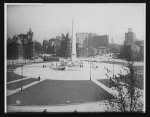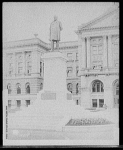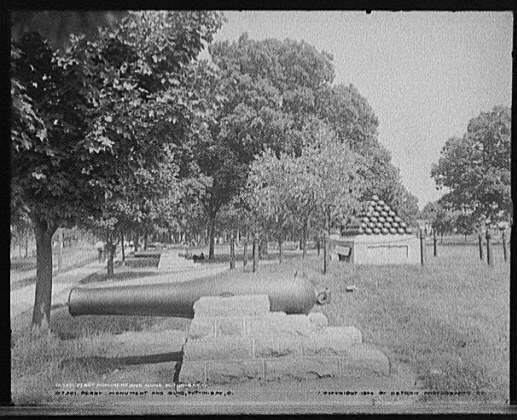
Other Commemorative Practices
President William McKinley and Commodore Oliver Hazard Perry are the two most commemorated figures in Ohio, and various methods of commemoration have been dedicated to their memory.
Local communities in Ohio have also erected memorials to McKinley in Dayton, Toledo
(seen at left), Cincinnati, and Cleveland, and Columbus (see The
William McKinley Memorial Monument). Additionally, the State of Ohio declared
the Red Carnation, McKinley's favorite flower and constant boutonniere, the state flower.
 Outside of Ohio, a
number of cities have memorialized McKinley. Chief among them is Buffalo, New York (right), where McKinley was
assassinated. Other memorials appear in Philadelphia, Chicago, and two cities in Massachusetts, Adams and Springfield.
Outside of Ohio, a
number of cities have memorialized McKinley. Chief among them is Buffalo, New York (right), where McKinley was
assassinated. Other memorials appear in Philadelphia, Chicago, and two cities in Massachusetts, Adams and Springfield.
McKinley is given national prominence with his likeness on the $500 bill. Mt. McKinley
National Park in Alaska, containing the largest mountain peak in the United States, was named in his honor in 1917.
PT, May 1998
|
The McKinley Memorial Monument |
Return home to: |
|
|
Return to Introductory Page |
More about the McKinley Memorial |
|
 commemoration
have been used to honor the War of 1812 hero and his victory in the Battle of Lake Erie. Camp Perry, an Ohio National Guard facility located
in Port Clinton, Ohio was named for him in May 1908, only a few months before the planning began for the centennial
celebration of Perry's victory. Perrysburg, Ohio, a suburb of Toledo, was also named after the naval hero for his
part in the War of 1812 battles held at Fort Meigs, now located within the city.
commemoration
have been used to honor the War of 1812 hero and his victory in the Battle of Lake Erie. Camp Perry, an Ohio National Guard facility located
in Port Clinton, Ohio was named for him in May 1908, only a few months before the planning began for the centennial
celebration of Perry's victory. Perrysburg, Ohio, a suburb of Toledo, was also named after the naval hero for his
part in the War of 1812 battles held at Fort Meigs, now located within the city.
Various monuments celebrate the battle and its hero. For decades only a lone
willow tree marked the burial site of the officers killed in the Battle of Lake Erie, but in 1852 a small memorial
made of old cannonballs was erected over the grave. As part of the centennial celebration, the soldiers were re-interred
in the Perry's Victory and International Peace Memorial but the original memorial still stands (left). Civil War financier Jay Cooke erected another
monument (right) on Gibraltar Island, a small island in Put-in-Bay harbor, to mark the 1859 cornerstone of a much
larger monument to Perry's victory planned for the site but never commissioned. Cleveland erected its own statue
of Commodore Perry in 1860; another monument stands in Buffalo, New York. These memorials commemorate Perry for
his skill in bringing about victory or they honor the men who died in the battle. The Perry's Victory and International
Peace Memorial is the only monument that remembers those who died as well as the peace they helped create.
SW, May 1998
|
Perry's Victory and International Peace Memorial |
Return home to: |
|
|
More about the Perry Memorial |
||
|
Cultural Geography (Site Specificity) |
||